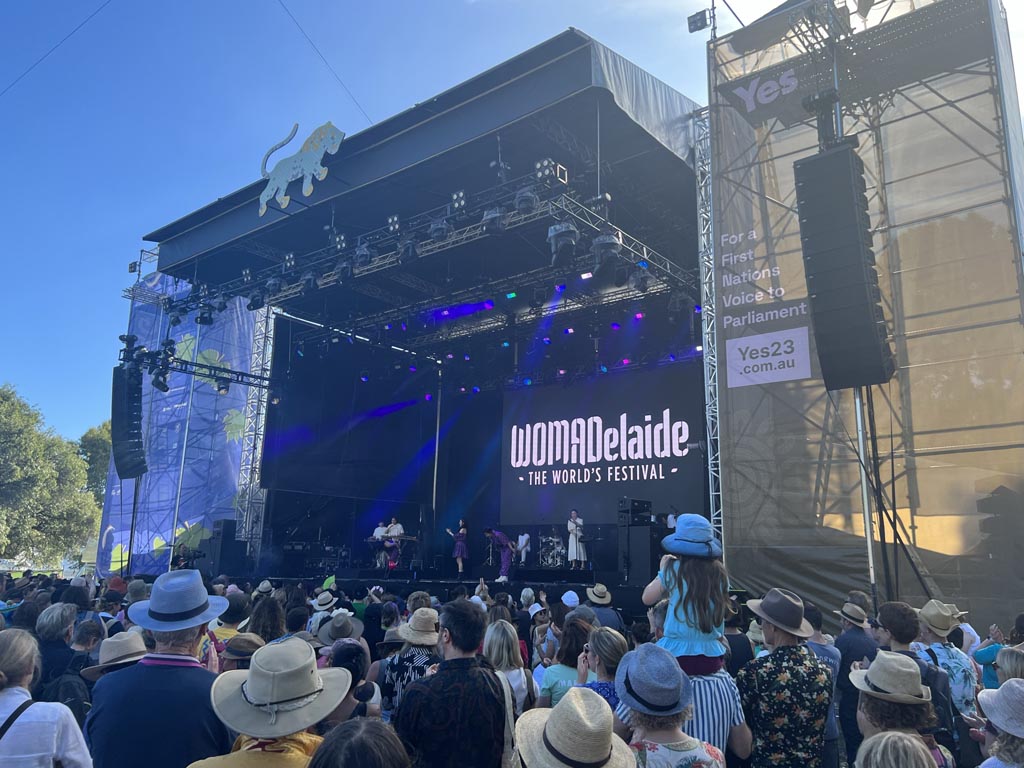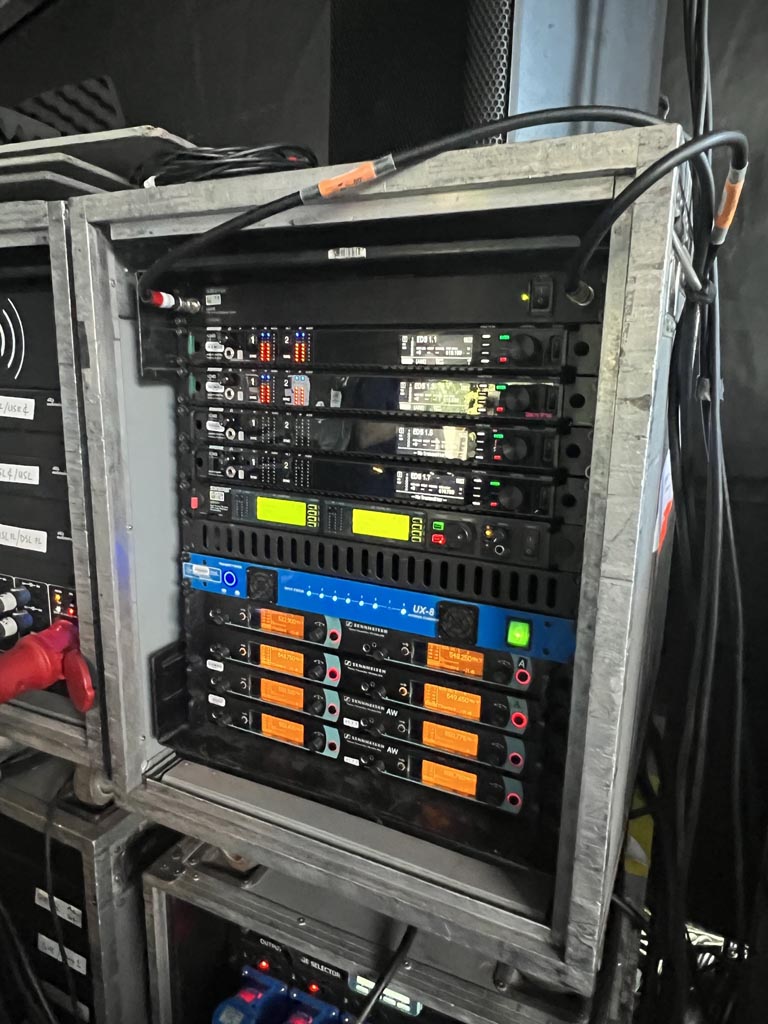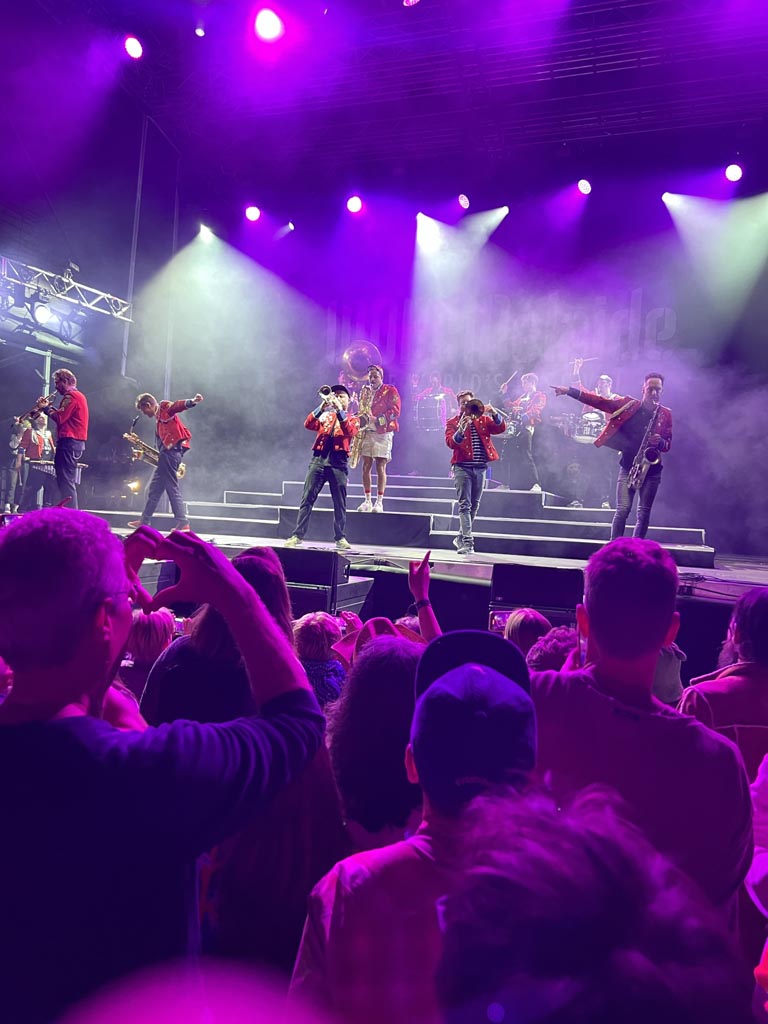TECH TALK
17 May 2023
Keeping the air clear at WOMADelaide

Subscribe to CX E-News
WOMADelaide 2023 was back at full international strength, with 700 artists from 30 countries, and with an increased capacity of 30,000 punters per day at Adelaide’s Botanic Park/ Tainmuntilla, helping make Mad March slightly madder than usual. High above WOMAD each night, French aerialists Gratte Ciel were dumping a tonne of white bird feathers, filling the air. The air was also full of RF, and it was the job of Profiles Resource Management’s Peter Twartz to make sure that RF was clean, even if he couldn’t keep the feathers out of the racks…
Over four massive days, including a public holiday Monday, WOMADelaide pulled 110,000 people through the doors. Headliners at WOMADelaide included Florence and the Machine, Bon Iver, Soul II Soul, and Youssou N’Dour. Not far away, Adelaide Fringe had taken over the parklands with The Garden of Earthly Delights and Gluttony. The Adelaide Festival itself was also on. No wonder hotels were expensive. But it wasn’t just thronged with people, there was also a lot of radio frequencies in play.

I met backstage with Peter Twartz as the main Foundation Stage thundered on behind us. This is PRM’s first time working WOMAD, and one of the reasons he was there was a rider. “Bon Iver’s rider calls for site-wide RF management,” reported Peter. As professionals, I think we all understand that specific clauses on riders usually mean something had gone less than well in the past. “Probably,” smiles Peter. “They had a paragraph in the rider asking for a list of all active frequencies, and to provide a proposed list for them. They had 14 channels of in-ear monitoring that they brought in.”
It’s a quite the task to manage RF across all seven stages, Kids Stage, and the Taste the World Pavilion, even with the site so large. “We’re blessed with the layout here, because not all of the stages affect each other,” observes Peter. “But Stage 3 will interfere with Stage 1, as will Stage 2. Every stage is within RF earshot of at least two other stages. The layout of the site and density of the trees are working for us, providing attenuation between stages. The stages are far enough apart that directional antennas aren’t pointing at each other, and the Fringe is far enough way not to be an issue.”

That’s all well and good for radio microphones and in-ear-monitors, but that’s not the only RF PRM are employed to deal with; there’s also comms. “Two-way radios are a different ball game,” explains Peter. “They push out 5W, and your 50mW radio mic will lose. And they’re press to talk; they don’t turn up on an RF scan unless someone’s actually talking into them. Of the 370 channels of RF we have under management here, 30 are two-ways. All of Production and Stage Management are on two-ways.”
Other comms are also in the RF soup. Two acts, including the aerialists, are using Clear- Com’s FreeSpeak II, which runs in the 1.9GHz DECT band. There’s also random media ENG crews. “The Press Manager tells me when there’s a media call or press conference,” Peter continues. “We had channels 7 and 9 and the ABC here this morning. They typically bring in Sony or Lectrosonic radio mics which are sitting right in our 520-694MHz range and need to be managed. The media crews here in Adelaide have worked together and divided up 40MHz of the radio spectrum between them, assigning around 100 frequencies between the five networks, that’s great for them, but I can’t afford to block out 40MHz. It’s up to me to find out from them which of these units will actually come to the press call, and what specific frequencies they’re using.”

There’s also the matter of steering clear of local television stations, which is not always as straightforward as it sounds. “Adelaide’s RF environment includes five TV channels you need to avoid,” states Peter. “The legislation says we’re allowed to operate in unused spectrum, but the exact wording is ‘not in the coverage area of a broadcasting station.’ There’s a coverage area called ‘Adelaide’ and all the big transmitters on top of Mount Lofty in the Adelaide Hills all transmit in the VHF band. But there’s also another coverage area called ‘Adelaide Foothills’ and they are lower power UHF trasnmitters. You’d think that wouldn’t be a problem, but you can see them on the scans.
That’s because the transmitters are on top of a building in the CBD pointing at the foothills, because the people who live on the front face of the hills miss the TV from Mount Lofty, as it goes straight over them.”
Integral to PRM’s work on large-scale events like WOMAD is FreqCoord, an online portal and total RF management tool developed by Swiss broadcaster SRF. “FreqCoord allows you to plot as many geographic locations and timeslots as you need,” Peter outlines. “The frequencies you have in use at 2 pm are available again after that act is gone, so they become available for the 7 pm show. That’s how we juggle 370 frequencies, as they’re not all active at once. FreqCoord accepts latitude and longitude data, so it knows how far each stage is apart. You can enter which bands you know you’ll be using, and import an RF scan from Shure, Sennheiser, or Wisycom.”
One of FreqCoord’s big strengths is how it networks all of the RF users on site, as opposed to just being a tool for the RF Manager. “I am networked to all the users,” Peter confirms. “If you want to use radio mics, I can send you a link, or you can log into the FreqCoord platform. You can then see when and where you’re proposing to use them.

You confirm and hit ‘submit’. That request comes into the frequency calculation engine, which I can see as the administrator. I then approve, disapprove, or change. The software allocates frequencies that work, and the user gets the details. The software manages all the communications to all the different parties, and the acts get all the information they need. Importantly, this means there’s an email trail, log file of correspondence, times, date, replies, comments, and requests.”
PRM were off next to manage the RF at the Slipknot-curated Knotfest, and then to multiple sporting events and stadiums, including Suncorp Brisbane, Queensland Country Bank Stadium in Townsville, and the ‘Gabba. They’re also managing the RF at Optus Stadium in Perth, the Gather Round in April for the AFL, the NRL’s Magic Round in Brisbane in May, and the State of Origin series, which this year includes another trip back to Adelaide.
Subscribe
Published monthly since 1991, our famous AV industry magazine is free for download or pay for print. Subscribers also receive CX News, our free weekly email with the latest industry news and jobs.






